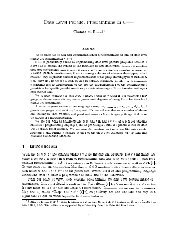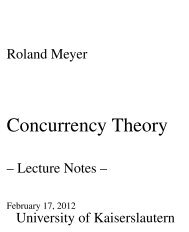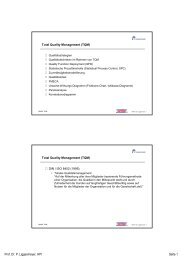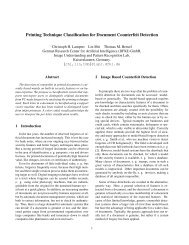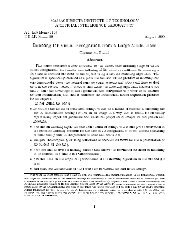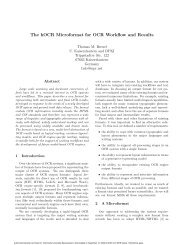Exercise Sheet 5 Problem 1: Lamport's Mutual Exclusion Algorithm ...
Exercise Sheet 5 Problem 1: Lamport's Mutual Exclusion Algorithm ...
Exercise Sheet 5 Problem 1: Lamport's Mutual Exclusion Algorithm ...
You also want an ePaper? Increase the reach of your titles
YUMPU automatically turns print PDFs into web optimized ePapers that Google loves.
Concurrency Theory (WS 2011/12) Out: Tue, Nov 15 Due: Mon, Nov 21<strong>Exercise</strong> <strong>Sheet</strong> 5Jun.-Prof. Roland Meyer, Georgel CălinTechnische Universität Kaiserslautern<strong>Problem</strong> 1: Lamport’s <strong>Mutual</strong> <strong>Exclusion</strong> <strong>Algorithm</strong>Consider the Petri net below, describing Lamport’s 1-bit mutual exclusion algorithm.cs 1 idle 1req 1nid 1 id 1after you 2await 2id 2req2cs 2idle 2(a) set up the colinear property one would want the mutex to satisfy and determine theconnectivity and trap matrices of the given Petri net;(b) prove that the basic verification system is feasible;(c) prove that the enhanced verification system is infeasible.How do you interpret the fact that bvs is feasable and evs infeasible?The exercise is a bit of work but demonstrates the power of the analysis technique. The exampleis taken from J. Esparza, S. Melzer: Verification of Safety Properties Using Integer Programming:Beyond the State Equation. Formal Methods in System Design 16(2): 159-189 (2000).<strong>Problem</strong> 2: Conflict vs. Causality vs. ConcurrencyProve that for occurrence net (B, E, G) and distinct x, y ∈ B∪E, precisely one of the followingholds:• x and y are causally related (i.e. x < y or x > y)• x and y are in conflict (i.e. x ♯ y)• x and y are concurrent (i.e. x co y)
<strong>Problem</strong> 3: Configurations and Firing SequencesLet C = {e 1 , . . . , e n } be a configuration with normal event ordering: i < j if e i < e j . Prove thate 1 . . . e n is a possible firing sequence in the unfolding, producing the marking ({e ⊥ } • ∪ C • )\ • C.<strong>Problem</strong> 4: Unfoldings, Configurations, and CutsConsider the Petri net depicted below:(a) unfold the Petri net and outline one of its prefixes;(b) describe/list all the configurations and cuts of your unfolding.p 1 p 2t 1 t 2p 3t 3p 4 p 5t 4p 6 p 7Why is your unfolding finite?




